
The poem "The Golden Journey to Samarkand," by James Elroy Flecker, has no doubt launched countless journeys to the ancient Silk Road city in southern Uzbekistan.
The 14th century capital of Tamerlane's empire remains the capital of the province that bears its name, and is the second largest city in Uzbekistan.
Most tourists headed to Samarkand will be arriving from Tashkent. There are domestic flights from Tashkent Airport (TAS) directly to Samarkand International (SKD) on Uzbekistan Airways. Other options include the Afrosiyob fast train, which gets visitors from Tashkent to Samarkand in less than three hours, as well as a host of slower trains. For those looking for a "cozier" and distinctly more local experience, a place in a shared taxi can be secured for ~$15 USD or less, depending on your bargaining skills. The drive takes five to six hours.
People come to Samarkand for history. The city was a center of Islamic learning for centuries, until it was razed by Ghengis Khan in 1220. With the rise of Tamerlane and the Timurid Empire, Samarkand returned to prominence, and it was during this era that the majority of the noteworthy historic sights were built.
With an early start, it is possible to make it through all of the major sights in Samarkand in one day, although some visitors may prefer to linger and spread their visit out over two or three days.
First on the agenda, should be the Gur Emir Mausoleum, Tamerlane's tomb. Unsurprisingly, the great conqueror known for butchering his enemies and piling their remains into grisly pyramids of skulls had a grand final resting place erected for himself. While the interior of the mausoleum in impressive and home to the world's largest piece of jade, Tamerlane's remains are not actually located here. There are all manner of legend about where they have been moved over the years, with the most fascinating tidbits centered on World War II and the Soviet era, but in the end, no one can be certain where Tamerlane's remains are located today. 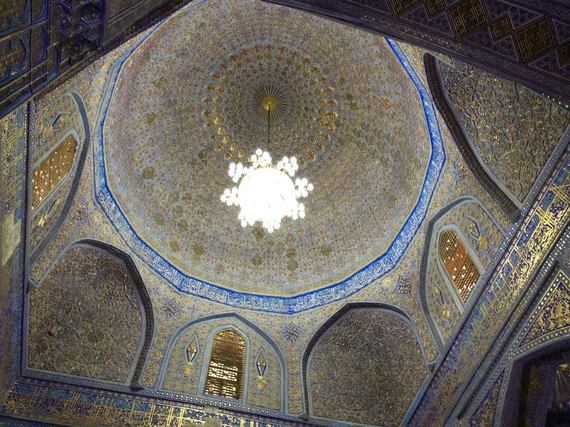
A short walk from Gur Emir is the big one, the postcard picture that everyone has in their mind when they think of Samarkand.
The Registan was the main public square when Samarkand was the vibrant capital of the Timurid Empire. The vast square is open on one end and framed by the Ulugh Beg Madrassa, Sher-dor Madrassa and Tilya-Kori Madrassa on the other three sides. It is one of the few sights that is as impressive in person as one would imagine it to be. For fledgling photographers, there are several places to take up positions in order to get shots of the entire ensemble. It is an incredible structure, on par with wonders of the world like the Taj Mahal. 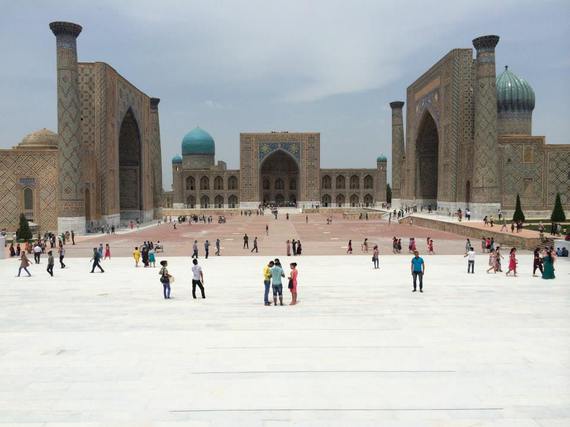
After lingering at the Registan, you can follow the street signs down a pedestrian way towards the Bibi Khanym mosque. After a campaign in India, Tamerlane ordered the creation of this mosque, which was said to have the highest minaret of any in the known world at the time. Ever the romantic, the mosque is named for his wife. The mosque has been restored numerous times over the years after falling into disrepair and being damaged in earthquakes. While almost none of the original construction remains, and the restoration is still a work in progress, it is a very impressive piece of architecture. 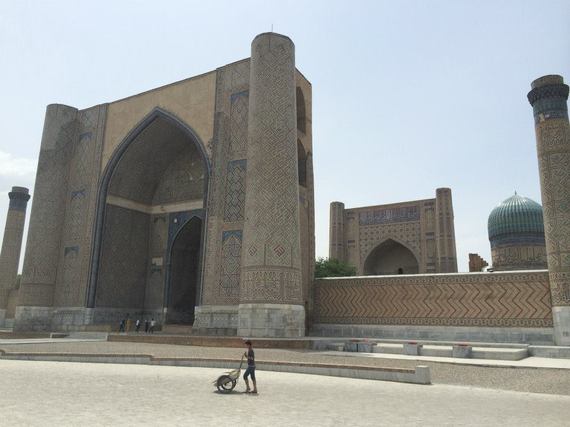
A slightly longer walk and a jump across the highway will bring you to the Shaki-Zinda Necropolis. This complex is famous both for its architecture and because it houses a large number of tombs and mausoleums, including the mausoleum of Shah E Zinda, who was the first cousin of the Prophet Muhammad. 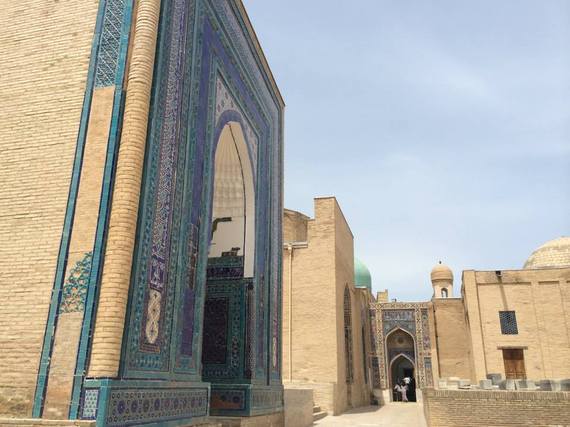
From here, hail a taxi and head to the Tomb of the Prophet Daniel. While Susa, Iran claims that it is the burial place of the Prophet Daniel, Samarkand has a competing claim. The Uzbek version of events claims that Tamerlane was attempting to annex the territory that is modern day Syria and was having great difficulty. It was suggested that Tamerlane's inability to secure victory was due to the bones of the Prophet Daniel being interred in the land he was trying to conquer. Tamerlane sent his army to acquire Daniel's bones and bring them back to Samarkand. As the story goes, once the bones were reburied in Samarkand a natural spring with the power to heal fortuitously sprung up on that spot, and Tamerlane was able to proceed with his campaign in Syria. You be the judge. 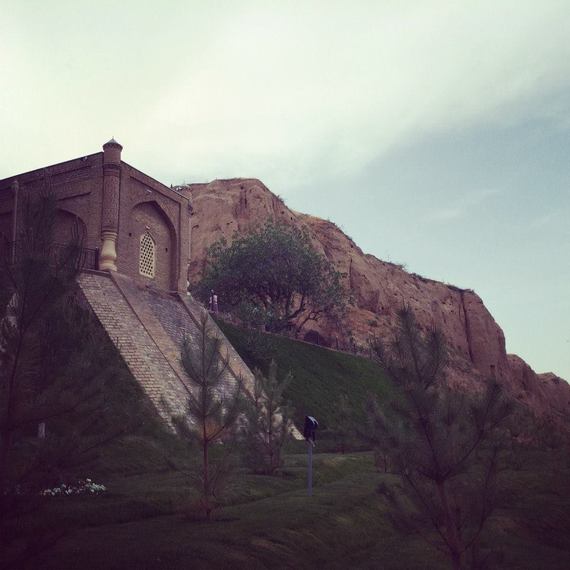
The last major sight to see is Ulugh Beg's Observatory. This is just a short walk from the Tomb of Daniel. Ulugh Beg was Tamerlane's grandson. When he ascended to the throne of the Timurid Empire, his interests were focused more on the cosmos than on conquest. In 1428, he built the enormous observatory and contributed greatly to astronomy, compiling a valuable star record. By the late 1440's his power began to wane and he was deposed and beheaded. After his death the observatory fell into ruin and today little is left. Despite the fact that only a limited amount of the observatory remains, visitors can easily grasp the scope and size of what the original must have been like, and there is a small museum with information about Ulugh Beg as well as a monument. 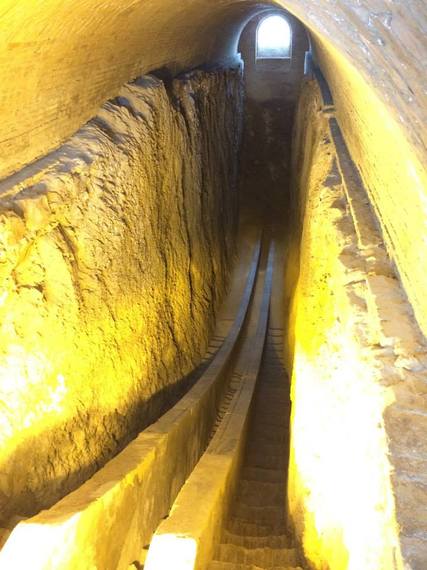
After working through all the historical sites, visitors can wander around the nearby town. There is also a small bazaar near Bibi Khanym where you can purchase local handicrafts as well as some of the Samarkand non, a bread famous throughout Uzbekistan. If you haven't had your fill of traditional Uzbek cuisine already make your way to Restaurant Samarkand for dinner.
Visitors planning to only spend the day in Samarkand should take at least some time to wander around the town away from the major tourist attractions, as there is a distinct culture in this part of Uzbekistan, only a five hour drive from Termez on the Uzbek side of the Uzbekistan-Afghanistan border. Samarkand offers a much different feeling than Tashkent, and it should be explored before your long caravan stretches back out across the plain.